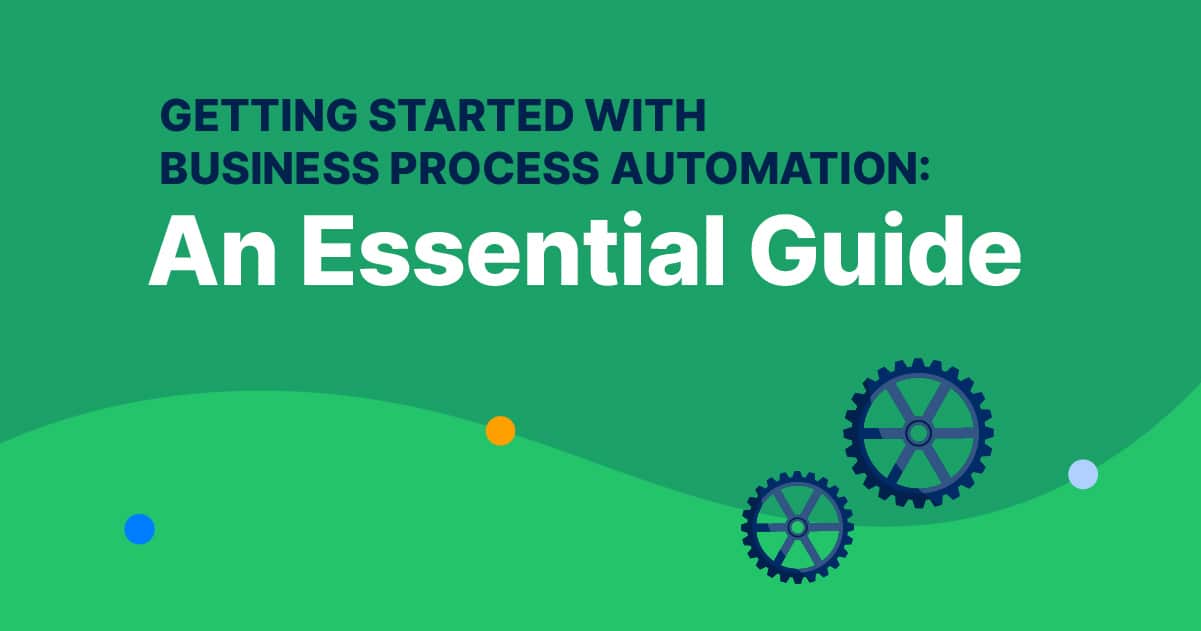Ready to revolutionize business operations? Welcome to business process automation! Whether you want to automate business processes or streamline mundane tasks, intelligent automation tech can help take your business operations to the next level. With this guide, you’ll learn how to use business process automation efficiently and cost-effectively! Keep reading for all of the tips and tricks you need to get started with business process automation.

Automate Your Work
Capacity’s enterprise AI chatbot can help:
- Answer FAQs anytime, anywhere
- Find relevant documents within seconds
- Give surveys and collect feedback
What is business process automation?
Business process automation (BPA) employs software to streamline and simplify complex, multi-step business operations. Compared to other varieties of automation, BPA solutions are often linked with various enterprise IT systems and customized precisely for an organization’s needs.
Business process automation can be a game-changer for organizations looking to streamline their daily business operations. BPA solutions eliminate manual data entry, reduce human error, and automate tedious, time-consuming tasks—all of which can save businesses money and valuable resources.
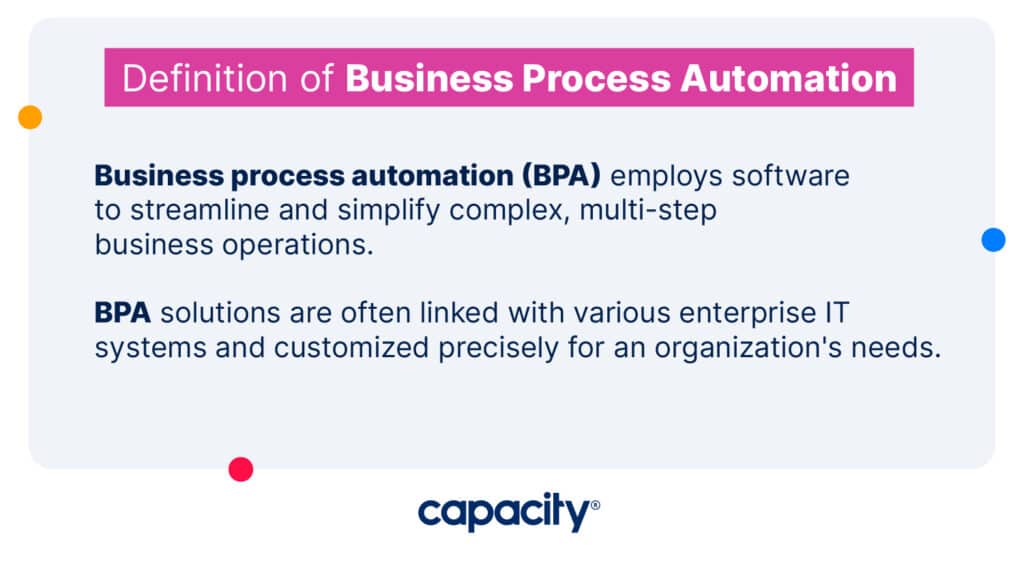
Why automate business processes?
Automating business processes can help companies organize their operations with improved accuracy, consistency, reliability, and scalability. BPA helps automate workflows by eliminating the need for manual data entry and reducing human error. Additionally, business process automation allows organizations to automate customer service processes and provide a more seamless customer experience. Automated business processes also enable data-driven decision-making, which helps businesses to gain real-time insights into their operations. Finally, automating business processes can help companies reduce costs associated with manual labor and free up resources for other business priorities.
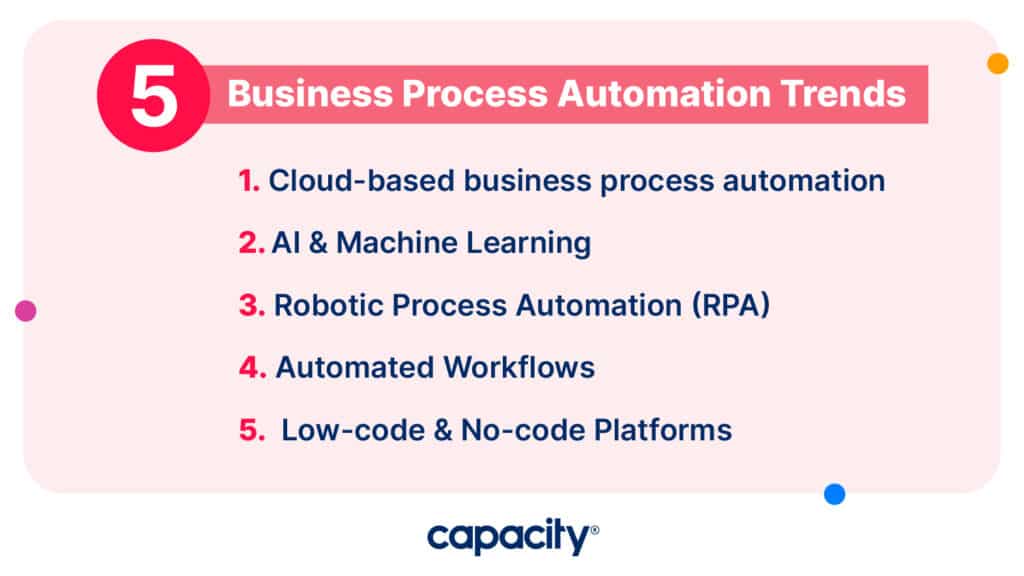
5 business process automation trends
Business process automation is quickly evolving and adapting to the latest technologies. AI, Machine Learning, RPA, cloud automation, and low code platforms are being more frequently used – as well as out-of-the-box integrations that streamline business processes for greater efficiency.
1. Cloud-based business process automation
More organizations are leveraging cloud technology to automate business processes and optimize operations. Cloud-based BPA solutions provide a suite of features for businesses to quickly and securely deploy business applications without any hardware requirements or software maintenance overhead costs.
When selecting a solution for your business, ensure they provide an accessible cloud platform where tasks and processes can be executed safely, transparently, and effortlessly – all under your oversight. It’s also essential to ensure the service provides comprehensive administrative tools so users may monitor each case or task requiring attention in real-time.
2. AI & Machine Learning
Businesses increasingly use artificial intelligence (AI) and machine learning (ML) technologies to automate complex business processes such as customer service cases, fraud detection, and analytics tasks. These tools can quickly analyze large data sets, detect patterns, and make decisions instantly with improved accuracy and efficiency compared to traditional business processes.
By leveraging AI technology, business process automation can reduce error proneness and generate improved outcomes. In addition to handling data analysis, AI significantly enhances the customer experience by allowing chatbots to handle simple inquiries while human representatives focus on more intricate issues. This level of precision and automation makes it easier for businesses to improve both their customer service processes and operational efficiency.
3. Robotic Process Automation (RPA)
Robotic process automation (RPA) is a game-changing technology that automates business processes. It helps organizations reduce manual labor and free up resources to focus on other business needs. RPA eliminates tedious and time-consuming tasks such as data entry, document processing, and customer service – which can be highly error-prone when done manually. Additionally, RPA offers analytics capabilities that can provide valuable business insights and enable data-driven decision-making.
By leveraging RPA, businesses have the potential to reduce costs while simultaneously improving operational efficiency significantly. Ultimately, robotic process automation is a powerful tool that transforms business processes and creates opportunities for organizations worldwide.
4. Automated Workflows
Businesses are deploying automated workflow technologies to manage business processes efficiently with improved accuracy and scalability. Automated workflows allow companies to quickly configure business rules and decisions that must be made within a process.

Automated workflows are essential for business process automation as they automate decision-making processes, allowing business processes to be executed faster. They also enable organizations to quickly customize business rules and decisions that must be made within a process. Additionally, companies can use automated workflows to initiate tasks and track process progress in real-time. This leads to improved business analytics and visibility of processes. Automated workflows provide organizations with a powerful solution to optimize business processes and improve overall efficiency.
5. Low-code & No-code Platforms
Low-code/no-code platforms provide a powerful way for business users with no coding experience to easily create business applications without the need for complex development skills. These platform solutions reduce the time it takes to develop business applications and provide businesses with an economical way to automate business processes quickly.
Low-code/no-code platforms are a great way to automate business processes as they reduce the time and cost of developing business applications. It also eliminates the need for complex coding skills, making it easier for business users with no coding experience to create business applications quickly and easily. This enables businesses to automate customer onboarding, employee onboarding, order processing, and more tasks with minimal effort. Low-code/no-code platforms allow companies to quickly and easily customize business processes to fit their needs.
In conclusion, business process automation can benefit organizations looking to streamline business operations. From cloud-based solutions to artificial intelligence and robotic process automation, there are many different types of business process automation trends that businesses should consider when assessing their business processes.
What business processes can be automated?
The first step towards streamlining your business operations begins with assessing and pinpointing mundane, repetitive tasks. When thinking about automation to optimize productivity, you should consider automating these primary processes:
- Tedious manual processes
- Duplicate assignments across various workflows
- Inefficient or outdated operations
- Time-sensitive or urgent tasks
- Instant responses to customer FAQs
- Inventory management
- Customer experience improvements
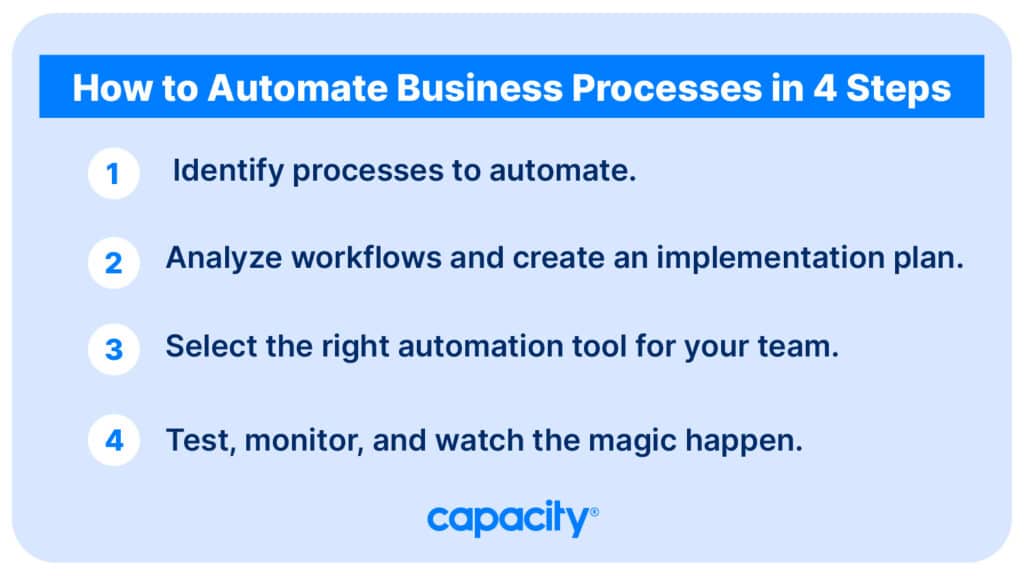
How to automate business processes in 4 steps
By pinpointing repetitive tasks and leveraging technology to optimize operations, businesses can efficiently automate business processes in a few easy steps:
Step 1: Identify processes to automate
Step one in business process automation is identifying processes your organization can automate. Businesses should assess their current operations and pinpoint any mundane, repetitive tasks. Businesses should consider automating tedious manual processes, duplicate tasks, and instant responses to customer FAQs when determining which business processes to automate. Make a list of business processes that can be automated and consider the potential benefits, such as time savings and improved accuracy.
Step 2: Analyze workflows and create an implementation plan
Analyze the business process you’ve identified for automation by breaking it down into smaller steps. Understand how each step is executed and identify areas within the business process that could be streamlined for employees. This step should also include evaluating each business process’s technical and business requirements, including any security considerations that need to be considered. Once these logistics are handled, work with every team to nail down an implementation plan.
Step 3: Select the right automation tool for your team
After identifying business processes that could benefit from automation and analyzing them in detail, select the right automation tool or technology for your business needs. Consider these factors when choosing a process automation platform:
- cost-effectiveness
- scalability
- usability and interfaces
- security options
- integration capabilities
Step 4: Test, monitor, and watch the magic happen
Once you’ve selected the business process automation tool or technology, test and monitor operations to ensure the automated process runs smoothly and efficiently. Continuous monitoring helps you identify any areas of improvement right away. Additionally, business process automation can be monitored and tweaked as business needs change.
Businesses can unlock efficiency gains and increased productivity by following these steps to automate business processes. Automation can reduce human labor costs, save resources for strategic tasks, and improve business outcomes.
Introducing Capacity: Your business process automation platform
Organizations of all sizes can unlock business process automation to streamline operations, improve customer experience, and drive business outcomes. Companies can instantly assign tasks and workflows with the right business process automation platform like Capacity.
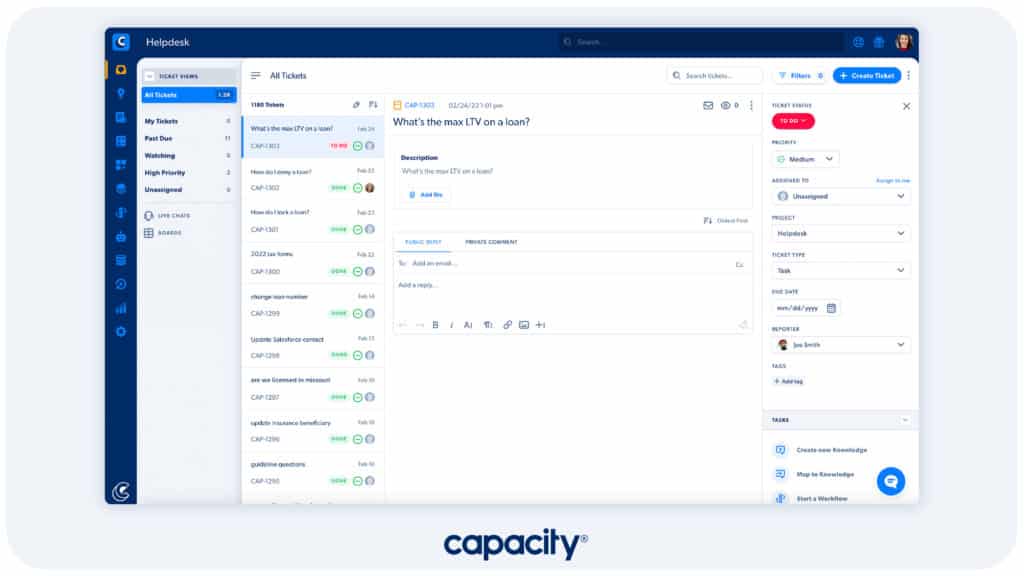
Ultimately, Capacity is the leading business process automation platform designed to help teams automate mundane, repetitive tasks and unlock efficiency gains. Capacity’s intuitive interface allows business teams to quickly identify business processes that can be automated in just a few clicks.
Through advanced AI capabilities, Capacity automates over 90% of tedious business tasks, freeing up resources for more strategic activities.
With powerful analytics and reporting features, businesses gain visibility into how operations are running and get real-time insights on performance. By leveraging Capacity’s process automation solution, companies can streamline their workflow for ultimate efficiency and productivity gains.


